#louis thomas hardin
Explore tagged Tumblr posts
Text
Elf Dance, originally composed by Moondog, performed by Vanessa Wagner on Inland, and reinterpreted by Suzanne Ciani on the remix EP Inland Versions
#music#piano#infiné#piano music#infiné records#vanessa wagner#moondog#remix#suzanne ciani#louis thomas hardin#louis hardin#kompakt studios#jörg burger#Bandcamp
32 notes
·
View notes
Text




W A T C H I N G
I saw this as a kid on TV, it's the first time I felt myself start understand that the kids who weren't white in my school were treated different. Sometimes by whispers between white kids.
Strange way to learn a lesson about society.
My best friend was a VERY white passing biracial Puerto Rican. But his father was very dark. And the kids snickered and murmured the n-word when he came to pick him up. They told him often, "you must be adopted."
It was confusing for me because I didn't get it. He was just my friend's dad. Like my dad had a European accent, and I didn't.
I just remember I was about 8 or 9 and even teared up at the at the speech that James Earl Jones gives at the end. It really stuck with me for while. It effected me kind of deeply. That even thinking about that day, I'm choked up.
It was a goofy 80s comedy, but for a suburban white kid like me, the message hit me how it was meant to.
Professor Banks: You've learned something I can't teach them. You've learned what it feels like to be black.
Mark: No sir.
Professor Banks: Beg your pardon?
Mark: I don't really know what it feels like, sir. If I didn't like it, I could always get out. It's not the same, sir.
Professor Banks: You've learned a great deal more than I thought.
‐---------------------
Legacy & input by actors from the movie:
———————
Rae Dawn Chong defended the film, saying of the controversy:
It was only controversial because Spike Lee made a thing of it. He'd never seen the movie and he just jumped all over it… He was just starting and pulling everything down in his wake. If you watch the movie, it's really making white people look stupid… [The film] is adorable and it didn't deserve it... I always tried to be an actor who was doing a part that was a character versus what I call 'blackting,' or playing my race, because I knew that I would fail because I was mixed [Chong is of African, Chinese and European ancestry]. I was the black actor for sure, but I didn't lead with my epidermis, and that offended people like Spike Lee, I think. You're either militant or you're not and he decided to just attack. I've never forgiven him for that because it really hurt me. I didn't realize [at the time] that not pushing the afro-centric agenda was going to bite me. When you start to do well people start to say you're a Tom [as in Uncle Tom] because you're acceptable.
Spike Lee responded by saying, "In my film career, any comment or criticism has never been based on jealousy."
"A white man donning blackface is taboo," said C. Thomas Howell. "Conversation over — you can't win. But our intentions were pure: We wanted to make a funny movie that had a message about racism."
Howell later expanded:
I'm shocked at how truly harmless that movie is, and how the anti-racial message involved in it is so prevalent... This isn't a movie about blackface. This isn't a movie that should be considered irresponsible on any level... It's very funny... It made me much more aware of the issues we face on a day-to-day basis, and it made me much more sensitive to racism... It's an innocent movie, it's got innocent messages, and it's got some very, very deep messages. And I think the people that haven't seen it that judge it are horribly wrong. I think that's more offensive than anything. Judging something you haven’t seen is the worst thing you can really do. In fact, Soul Man sort of represents that all the way through. I think it's a really innocent movie with a very powerful message, and it's an important part of my life. I'm proud of the performance, and I'm proud of the people that were in it. A lot of people ask me today, 'Could that movie be made today?'... Robert Downey Jr. just did it in Tropic Thunder!... The difference is that he was just playing a character in Tropic Thunder, and there was no magnifying glass on racism, which is so prevalent in our country. I guess that's what makes people more uncomfortable about Soul Man. But I think it's an important movie.
Robert Downey Jr. referenced Howell and Soul Man when addressing the potential controversy over his role in Tropic Thunder: "At the end of the day, it's always about how well you commit to the character. If I didn't feel [the role in Tropic Thunder] was morally sound, or that it would be easily misinterpreted that I'm just C. Thomas Howell [in Soul Man], I would've stayed home."
Mathcore band Botch has a track named "C. Thomas Howell as the 'Soul Man'" on their album We Are the Romans (1999).
#SOUL MAN (1986)#C. THOMAS HOWELL#JAMES EARL JONES#Rae Dawn Chong#Arye Gross#Melora Hardin#Leslie Nielsen#James B. Sikking#Julia Louis-Dreyfus#Steve Miner#80s movies#controversial movies#comedy
3 notes
·
View notes
Text

Storia Di Musica #348 - Jimmy Raney, A, 1957
La Storia della Prestige Records è anche la storia di una intera generazione di musicisti che ebbe la possibilità di incidere, sebbene in modo anticonvenzionale, con la creatura di Bob Weinstock. Weinstock è famoso per altri motivi, su cui ritornerò nelle prossime storie, prima fra tutte la sua estrema "parsimonia" economica, eppure fu un grandissimo talent scout, con un fiuto davvero notevole, tanto che fu fenomenale nel far registrare più cose possibili ad artisti che sapeva sarebbero poi andati verso concorrenti più grandi ed economicamente attrezzati. Oltre a ciò, viveva un eclettismo di produzione che pochissime case editrici avevano: registrò dischi di arpa jazz, duo e trio con strumenti inusuali, persino di musica d' avanguardia (i tre album che Louis Thomas Hardin, conosciuto come Moondog, incise per la Prestige tra il 1956 e il 1957). Il disco di oggi segue un'altra delle passioni di Weinstock, la chitarra jazz. E mise sotto contratto uno dei più fenomenali chitarristi del bop jazz, Jimmy Raney.
Originario del Kentucky, Raney giovanissimo sostituì alla chitarra Tal Farlow, altra leggenda dello strumento e soprannominato Octopus per le sue grandi mani, nel Trio di Red Norvio, altro gigante, vibrafonista, soprannominato Mr. Swing. Parallelamente all'impegno con il trio, è scelto da Stan Getz per una collaborazione che fece scuola, e che regalò a Raney una fortissima fama: nel 1956 vinse il prestigioso concorso della rivista Downbeat come miglior chitarrista del jazz. Eclettico, capace di spaziare tra i vari generi, Raney fu prolifico nonostante due limiti: le sue dipendenze, soprattutto dall'alcool, che lo terranno spesso lontano dalle scene nella seconda parte della sua carriera, e un impedimento fisico, cioè la Sindrome di Menière, una patologia dell'orecchio che gli provocava vertigini, nausee e drammatici momenti dove muoveva in maniera incontrollata gli occhi verticalmente.
Per la Prestige, oltre che come sessionista, incise due dischi, uno in coppia con Kenny Burrell, altro grandissimo chitarrista, (2 Guitars, del 1957), e il disco di oggi, dove come poche volte la chitarra è protagonista in un quartetto jazz. A è composto da diverse sessioni di registrazione, tenute nel mitico Van Gelder Studio di Hackensack, New Jersey, tra il Maggio del 1954 e due giorni, a Febbraio e Marzo del 1955. Insieme a Raney ci sono John Wilson alla tromba, Hall Overton al pianoforte, Teddy Kotick al contrabbasso e due batteristi Art Mardigan (nella registrazione del 1954) e Nick Stabulas (in quelle del 1955). Nei brani si sviluppa tutto l'ecclettismo e la maestria del chitarrista e il suo valore come band leader. Si sperimenta persino l'overdubbing nella spettacolare Minor, brano autografo di Raney, (che si basa sui cambi di accordi di Bernie's Tune); bellissima è anche Double Image (ispirata a There Will Never Be Another You), più un contrappunto selvaggio improvvisato tra Raney e il pianista Hall Overton in On the Square e un'intricata interpretazione della ballata Some Other Spring. John Wilson viene aggiunto alla tromba per la seconda e la terza data in studio, che consistono principalmente di standard. La vivacemente swingante Spring Is Here, una dolce What's New? di Bob Haggart e una delicatissima You Don't Know What Love Is, che dopo il successo come canzone di film anni '40 era diventata in breve tempo uno standard dopo la registrazione che Miles Davis ne fece nel 1954. Gli originali di Raney includono One More For The Mode, una piacevole rielaborazione di un'invenzione in due parti di Johan Sebastian Bach, e Tomorrow, Fairly Cloudy, un bop fiammeggiante. Completano la scaletta due riletture sentite a due classici: A Foggy Day e Someone To Watch Over Me dei superbi George Gershwin e Ira Gershwin.
Raney ebbe una seconda, ma minore, fama all'inizio degli anni '70, quando firmò un contratto per un'altra casa discografica del jazz indipendente, la Xanadu, con cui incise un bellissimo album, Influence, del 1975. Con lui in quegli anni suonava suo figlio Doug, chitarrista anch'egli, e un altro figlio musicista, Jon, cura un sito memoriale, The Raney Legacy, che raccoglie materiale sul padre e figlio chitarristi. Quando morirà, nel maggio del 1995 a soli 67 anni, il New York Times gli dedicherà un lungo articolo omaggio, descrivendolo come "one of the most gifted and influential postwar jazz guitarists in the world".
8 notes
·
View notes
Text
names, mostly surnames (1)
let me apologise for this partial list of names in the library, titles available on request...
, Adorno, horkheimer, anderson, aristotle, greta adorno, marcuse, agamben, acampora and acampora, althussar, lajac kovacic, eric alliez, marc auge, attali, francis bacon (16th c), aries, aries and bejin, alain badiou, beckett, hallward, barnes, bachelard, bahktin, volshinov, baudrillard, barthes, john beattie, medvedev, henri bergson, Jacques Bidet, berkman, zybmunt bauman, burgin, baugh, sam butler, ulrich beck, andrew benjamin and peter osbourne, walter benjamin, ernest bloch, blanchot, bruzins, bonnet, karin bojs, bourdieu, j.d. bernal, goldsmith, benveniste, braidotti, brecht, burch, victor serge, andre breton, judith butler, malcolm bull, stanley cohen, john berger, etienne balibar, david bohm, gans blumenberg, martin buber, christopher caudwell, micel callon, albert camus, agnes callard, castoridis, claudio celis bueno, carchedi and roberts, Marisol de la cadena, mario blaser, nancy cartwright, manual castells, mark currie, collingwood, canguilhem, mario corti, stuart hall, andrew lowe, paul willis, coyne, stefan collini, varbara cassin, helene cixous, coward and ellis, clastres, carr, cioren, irving copi, cassirer, carter and willians, margeret cohen, Francoise dastur, guy debord, agnes martin, michele bernstein, alice, lorraine dastun, debaise, Gilles Deleuze, deleuze and gattari, guattari, parnet, iain mackenzie, bignall, stivale, holland, smith, james williams, zourabichvili, paul patton, kerslake, schuster, bogue, bryant, anne sauvagnargues, hanjo berresen, frida beckman, johnson, gulliarme and hughes, valentine moulard-leonard, desai, dosse, duttman, d’amico, benoit peters, derrida, hinca zarifopol-johnston, sean gaston, discourse, mark poster, foucault, steve fuller, markus gabrial, rosenbergm milchamn, colin jones, van fraasen, fekete, vilem flusser, flahault, heri focillon, rudi visker, ernst fischer, fink, faye, fuller, fiho, marco bollo, hans magnus enxensberger, leen de bolle, canetti, ilya enrenberg, thuan, sebastion peake, mervyn peake, robert henderson, reimann, roth, bae suah, yabouza, marco bellatin, cartarescu, nick harkaway, chris norris, deLanda, regis debray, pattern and doniger, soame jynens, bernard williams, descartes, anne dufourmanteille, michelle le doeuff, de certaeu , deligny, Georges Dumezil, dumenil and levy, bernard edelman, victorverlich, berio, arendt, amy allen, de beauvior,hiroka azumi, bedau and humphreys, beuad, georges bataille, caspar henderson, chris innes, yevgeny zamyatin, louis aragon, italo calvino, pierre guirard, trustan garcia, rene girard, paul gilroy, michal gardner, andre gorz, jurgan gabermas, martin gagglund, beatrice hannssen, jean hyppolyte, axel honneth, zizek and crickett, stephen heath, calentin groebner, j.b.s. haldane, ian hacking, david hakken, hallward and oekken, haug, harman, latour, arnold hauser, hegel, pippin, pinksrd, michel henry, louis hjelmslev, gilbert hardin, alice jardine, karl jaspers, suzzane kirkbright, david hume, thomas hobbes, barry hindus, paul hirst, hindess and hirst, wrrner hamacher, bertrand gille, julien huxley, halavais, irigaray, ted honderich, julia kristeva, leibnitz, d lecourt, lazzaroto, kluge and negt, alexander kluge, sarah kofman, alexandre kojeve, kolozoya, keynes, richard kangston, ben lehman, kant, francous jullien, fred hameson, sntonio rabucchi, jaeggi, steve lanierjones, tim jackson, jakobson, joeseph needham, arne de boever, marx and engels, karl marx, frederick engels, heinrich, McLellen , maturana and varuna, lem, lordon, jean jacques-lecercle, malabou, marazzi, heiner muller, mary midgley, armand matterlart, ariel dorfman, matakovsky, nacneice, lucid, victor margolis, narco lippi, glen mazis, nair, william morris, nabis, jean luc nancy, geoffrey nash, antonio negri, negri and hardt, hardt, keith ansell pearson, pettman, william ruddiman, rheinberger, andre orlean, v.i. vernadsky, rodchenko, john willet, tarkovsky, william empson, michel serres, virillio, semiotexte, helmut heiseenbuttel, plessner, pechaux, raunig, retort, saito, serres, dolphin, maria assad, spinoza, bernard sharratt, isabelle stengers, viktor shklovsky, t. todorov, enzo traverso, mario tronti, todes, ivan pavlov, whitehead, frank trentmann, trubetzkoy, rodowink, widderman, karl wittfogel, peter handke, olivier rolin, pavese, robert walser, petr kral, von arnim, sir john mennis, ladies cabinet, samuel johnson, edmund spenser, efy poppy, yoko ogawa, machado, kaurence durrell, brigid brophy, a. betram chandler, maria gabriella llansol, fowler, ransmayr, novick, llewellyn, brennan, sean carroll, julien rios, pintor, wraxall, jaccottet, tabucchi, iain banks, glasstone, clarice lispector, murakami, ludmilla petrushevskaya, motoya, bachmann, lindqvist, uwe johnson, einear macbride, szentkuthy, vladislavic, nanguel, mathias enard, chris tomas, jonathan meades, armo schmidt, charles yu, micheal sorkin, vilas- matas, varesi, peter weiss, stephenson, paul legrande, virginie despentes, pessoa, brin, furst, gunter trass, umberto eco, reid, paul,klee, mario levero, hearn, judith schalansky, moorhead, margert walters, rodchenko and popova, david king, alisdair gray, burroughs, ben fine, paul hirst, hindess, kapuscinski, tchaikovsky, brooke-rose, david hoon kim, helms, mahfouz, ardret, felipe fernandez-armesto, young and tagomon, aronson, bonneuil and fressoz, h.s. bennett, amy allen, bruckner brown, honegger, bernhard, warren miller, albert thelen, margoy bennett, rose macauley, nenjamin peret, sax rohmer, angeliki, bostrom, phillip ball, the invisible commitee, bataille and leiris, gregory bateson, michelle barrett and mary mcintosh, bardini, bugin, mcdonald, kaplan, buck-moores, chesterman and lipman, berman, cicero, chanan, chatelet, helene cixous, iain cha,bers, smirgel, norman clark, caird, camus, clayre, chomsky, critchley, curry, swingewood, luigi luca cavelli-sforza, clark, esposito, doerner, de duve, alexander dovzhenko, donzelot, dennet, doyle, burkheim, de camp, darwin, dawkins, didi-huberman, dundar, george dyson, berard deleuze, evo, barbara ehrenrich, edwards, e isenstein, ebeking, economy and society, esposito, frederick gross, david edgeerton, douglas, paul,feyerband, jerry fodor, gorrdiener, tom forester, korsgaard, fink, floridi, elizabeth groscz, pierre francastel, jane jacobs, francois laplantinee, gould, galloway, goux, godel, grouys, genette, gil, kahloo, giddens, martin gardner, gilbert and dubar, hobbes, herve, golinski, grotowski, glieck, hayles, heidegger, huxley, eric hobsbawn, jean-louis hippolyte, phillip hoare, tim jordan, david harvey, hawking, hoggart, rosemary jackson, myerson, mary jacobus, fox keller, illich, sarah fofman, sylvia harvey, john holloway, han, jaspers, yuk hui, pierre hadot, carl gardner, william james, bell hooks, edmond jabes, kierkegaard, alexander keen, kropotkin, tracy kidder, mithen, kothari and mehta, lind, c. joad, bart kosko, kathy myers, kaplan, luce irigaraay, patrick ke iller, kittler, catherine belsey, kmar, klossowski, holmes, kant, stanton, ernesto laclau, jenkins, la mouffe, walter john williams, adam greenfield, susan greenfield, paul auster, viet nguyen, jeremy nicholson, andy weir, fred jameson, lacoue-labarthe, bede, jane gallop, lacan, wilden, willy ley, henri lefebvre, rob sheilds, sandra laugier, micheal lowy, barry levinson, sylvain lazurus, lousardo, leopardo, jean-francois lyotard, jones, lewontin, steve levy, alice in genderland, laing, lanier, lakatos, laurelle, luxemburg, lukacs, jarsh, james lovelock, ideologu and consciousness, economy and society, screen, deleuze studies, deleuze and guattari studies, bruno latour, david lapoujade, stephen law, primo levi, levi-strauss, emmanuel levinas, viktor schonberger, pierre levy, gustav landaur, robin le poidevin, les levidow, lautman, david cooper, serge leclaire, catherine malabou, karl kautsky, alice meynall, j.s. mill, montainge, elaine miller, rosa levine-meyer, jean luc marion, henri lefebrve, lipovetsky, terry lovell, niklas luhmann, richard may, machiavelli, richard mabey, john mullzrkey, meyerhold, edward braun, magri, murray, nathanial lichfield, noelle mcafee, hans meyer, ouspensky, lucretius, asa briggs, william morris, christian metz, laura mulvey, len masterman, karl mannheim, louis marin, alaister reynolds, antonio munoz molina, FRAZER, arno schmidt, dinae waldman, mark rothko, cornwall, micheal snow, sophie henaff, scarlett thomas, matuszewski, lillya brik, rosamond lehman , morris and o’conner, nina bawden, cora sandel, delafield, storm jameson, lovi , rachel ferguson, stevie smith, pat barker, miles franklin, fay weldon, crista wolff, grace paley, v. woolf, naomi mitchinson, sheila rowbotham, e, somerville and v ross, sander marai, jose saramago, strugatsky, jean echenoz, mark robso, vladimir Vernadsky, chris marker, Kim Stanley Robinson, mario leverdo, r.a. lafferty, martin bax, mcaulay, tatyana tolstaya, colinn kapp, jonathan meades, franco fortini, sam delany, philip e high, h.g. adler, feng menglong, adam thorpe, peeter nadas, sam butler, narnold silver, deren, joanna moorhead, leonara carrington, de waal, hartt, botticelli, charbonneau, casco pratolini, murakami, aldiss, guidomorselli, ludmilla petrushevskaya, ,schulz, de andrade, yasushi. inoue, renoir, amelie nothomb, ken liu, prynne, ANTIONE VOLODINE, luc brasso, angela greene, dorothea tanning, eric chevillard, margot bennett w.e. johns, conan doyle, samuel johnson, herge, coutine-denamy, sterling, roubaud, sloan, meiville, delarivier manley, andre norton, perec, edward upward, tom mcCarthy, magrinya, stross, eco, godden, malcolm lowry, derekmiller, ismail kadare, scott lynch, chris fowler, perter newman, suzzana clarke, paretky, juliscz balicki, stanislaw maykowski, rajaniemi, william morris, c.k. crow, ueys, oldenburg, mssrc chwmot, will pryce, munroe, brnabas and kindersley, tromans, lem, zelazny, mitchinson, harry Harrison, konstantin tsiolkovsky, flammerion, harrison, arthur c clarke, carpenter, john brunner, anhony powell, ted white, sheckley, kristof, kempowski, shingo, angelica groodischer, rolin, galeanom dobin, richard holloway, pohl and kornbulth, e.r. eddison, ken macleodm aldiss, dave hutchinson, alfred bester, budrys, pynchon, kurkov, wisniewski_snerg, , kenji miyazawa, dante, laidlaw, paek nam_nyong, maspero, colohouquon, hernandez, christina hesselholdt, claude simon, bulgaakov, simak, verissimo, sorokin, sarraute, prevert, celan, bachmann, mervin peake, olaf stapledon, sa rohmer, robert musil, le clezio, jeremy cooper, zambra, giorgio de chirico, mjax frisch, gawron, daumal, tomzza, canetti, framcois maspero, de quincy, defoe, green,, greene, marani, bellatin, khury, tapinar,, richmal crompton, durrenmat, fritz, quintane, volponi, nanni balestrini, herrera, robert walser, duras, peter stamm, m foster, lan wright, their theotokism agustn de rojas, paul eluard, sturgeon, hiromi kawakomi, sayaka murata, wolfgang hilbig, hmilton, z zivkovic, gersson, mallo, bird, chaudrey, Toussaint, Can Xue, Lewis Mumford, neitzsche, popper, zizek, scott westerfield, rousseau, lewis munford, tod may, penelope maddy, elaine marks, isabelle courtivron, leroi, massumi, david sterritt, godard, millican and clark, macabe, negri, mauss, maiimon, patrica maccormack, moretti, courtney humphries, monad, moyn, malina, picasso, goldman, dambisa moyo, merleau-ponty, Nicholson, knobe and nichols, poinciore, morris, ovid, ming, nail, thomas more, richard mabey, macfarlane, piscator, louis-stempal, negrastini, moore, jacquline rose, rose and rose, ryle, roszick, rosenburg, ravisson, paul ricoer, rossler, chantl mouffe, david reiff, plato, slater, rowlands, rosa, john roberts, rhan, dubios and rousseau, ronell, jacques ranciere, mallarme, quinodoz, peterpelbert, mary poovey, mackenzie, andrew price, opopper, roger penrose, lu cino parisi, gavin rae, parker and pollack, mirowoski, perniola, postman, panofsky, propp, paschke and rodel, andre pickering, massabuau, lars svenddsen, rosenberg and whyte, t.l.s. sprigger, nancy armstrong, sallis, dale spender, stanislavski, vanessa schwartz, shapin and shaeffer, sally sedgewick, signs, gabriel tarde, charles singer, adam smith, simondon, pascal chablt, combes, jon roffee, edward said, sen, nik farrell fox, sartre, fred emery, scholes, herbert spencer, ruth saw, spinoza, raphael sassower, henry sidgewick, peter singer, katarznya de lazari-radek, piaget, podach, van der post, on fire, one press, melossi and pavarini, pearl and mackenzie, theirry paquot, tanizaki, RHS, stone, richard sennett, graham priest, osborn and pagnell, substance, pedrag cicovacki, schilthuizen, susan sontag, gillian rose, nikolas rose, g rattery taylor, rose, rajan, stuart sim, max raphael, media culture and society, heller- roazen, rid, root, rossi, gramsci, showstack sasson, david roden, adrew ross, rosenvallion, pauliina remes, pkato, peter sloterdijk, tamsin shaw, george simmel, bullock and trombley, mark francis, alain supiot, suvin, mullen and suvin, stroma, maimonides, van vogt, the clouds on unknowing, enclotic, thesis 11, spivack, kate raworth, h.w. richardson, hillial schwartz, stern, rebecca solnit, rowland parker, pickering, lukacs, epicriud, epicetus, lucrtious, aurelies, w.j.oates, thor Hanson, thompson, mabey, sheldrake, eatherley, plato, jeffries, dorothy richardson, arno schmidt, earl derr biggersm mary borden, birrel, arno schmidt, o.a. henty, berhard steigler, victor serge, smith, joyce salisbury, pauer-studer, timpanaro, s helling, schlor, norman and welchman, searle, emanuele severarimo, tomasello, sklar, judith singer, walmisley, thomas malthus, quentin meilassoux, alberto meelucchi, mingione, rurnbull, said, spufford and uglow, zone, j.j.c. smartt, sandel, skater, songe-moller, strawson, strawson, strawson, raymond tallis, toscano, turkle, tiqquin, diggins, j.s. ogilivy, w.w. hutchings, rackgam, deiter roth, dowell, red notes, campbell and pryce,osip brik, lilya brik, mayakovsky, zone, alvin toffker, st exupery, freya stark, warson, walsh, wooley, tiles and oberdick, timofeeva, richardson, marcuse, marder, wright, ushenko, tolson, albebers and moholy- nagy, alyce mahon, gablik, burnett, barry, hill, fontaine, sanuel johnson,justin, block, taylor, peter handke, jacques rivette, william sansom, bunuel and dali, tom bullough, aldius huxley, philip robinson, spendor, tzara, wajcman, peter wohlleben, prigogini, paolo virno, jeremy tunstall, theweliet, taussig, tricker, vince, thomss, williams, vogl, new german critique, e.p. thompson, jean wahl, paul virilio, lotringer, christy wampole, verhaeghe, janet wolff, anna kavan, vergara, uexkull, couze venn, barry smart, vico, vatimo, vernant, raoul vaneigem, ibn warraq, vertov, williams, meiksins wood, norbert weiner, peter wollen, h.g. wells, michelle walker, , jeanne waelit walters, shaw and darlen, whorf, ward and dubois, john wright, weinart, wolff, willis, wark, cosima wagner, j. weeks, judith williamson, welzbacher, erik olin wright, wittgenstein, kenny, zeldin, wenders, henry miller, wenkler, arrighi, banks, innes, ushereood, kristeva, john cage, quignard, t.f. powys, siri hustveldt, lem, zelazny, mitchonson, tsilolkovsky, toussaint, heppenstall, garrigasait, de kerangal, haine fenn, jean bloch, geoff ryman, reve, corey, asemkulov, ernaux, gareth powell, cory, deleuze and guattari studies, cse, allain and souvestre, apolinaire, jane austen, john arden, aitmatov, elizabth von arnim, paul auster, abish, ackroyd, tom gunn, lorca, akhmatov, artuad, simon armatige, albahari, felipe alfau, audem auden and soendor, varicco, barrico, bainbridge, asturias, ronan bennett, beckett, paul bowles, jane bowles, celine, bukowski, wu ming, blissert, kay boyle, andrei bely, hugo barnacle, BOLL, isak dineson, karen blikson, brodsky, richmel crompton, berry, barthleme, mary butts, leonora carrington, cage, chevhillard, canetti, cendres, butor, cortazar, danielewski, bertha damon, dyer, havier cercas, micheal dibden, marguerite duras, john donne, duras, durrell, dorrie, Fredric durrenmatt, heppenstahl, eco, enzensberger, evanovich, fruentes, farrell, alison fell, alisdair gray, hollinhurst, andre gide, jean giono, gadda, henry green, grass, andre gorz, william gibson, joyce, gombrowitz, alex laishley, murakami, herve guibert, franz kafka, juenger, junker, kapuscinski, laurie king, kundera, mcewan, ken macleod, ian macdonald, moers, meades, vonda macintyre, nalmstom, maillert, havier marias, jeff noon, anaus nin, david nobbs, peter nadas, nabokov, iakley, oates, raymond queneau, cesare pavese, paterson, ponge, perte, perec, chinery, ovid, genette, kandinsky, robert pinget, richard piwers, rouvaud, sloan, surrralist poetry, ilya troyanov, paul,raabe, julien rios, arne dahl, pierre sollers, rodrigruez, chris ross, renate rasp, ruiz, rulfo, tove jannsson, cabre, vladislavic, tokarczuk, pessoa, jane bowles, calvino, lispector, lydia davis, can xue, sebald, peter tripp, hertzberg, virginia woolf, zozola, sorrentino, higgins, v.w. straka, cogman, freud, jung, klein, winnecot, lacan, fordham, samuels, jung, freud, appignesai, bjp, pullman, magnam, sybil marshall, mccarten, galbraith, jewell, lehmann, levy, levin, jung, spinoza, fairburn, jung, sandler, lacan, laplanche, pontalis, can, xue, klein, cavelli, hawkins, stevens, hanna segal, bollas, welldon, williams, sutherland, buon, symington, morrison, brittain, sidoli, sidoli, holmes, bowlby, winnecott, bollas, kalschiid, malan, patrick casement, anna frued, wittenburg, liz wright, fordham, fairburn, symington, sandler, jung, balint, coltart, west, steiner, van der post, stern, green, roustang, adrew samuels, d.l. sayers, salom, krassner, swain, rame and fo, storr, cogman, hessen, penelope fitzgerald, cummings, richard holloway, juhea kim, glenville, heyer, cartland, kim, cho, atkinson, james, king, audten, hartley, du maurier, bronte, thomas, plath, leon, camillairi, kaussar, fred fargas, boyd, sjowall and wahloo, pheby, morenno-garcia, perrsson, herron, nicola barker, arronovitch, karen lord, stephen frosh, ernest jones, flamm o’brien, shin, mishra, chin jin-young and so on to the warm horizon
8 notes
·
View notes
Text
157: The Silver Mt. Zion Memorial Orchestra & Tra-La-La Band // "Born Into Trouble as the Sparks Fly Upward."
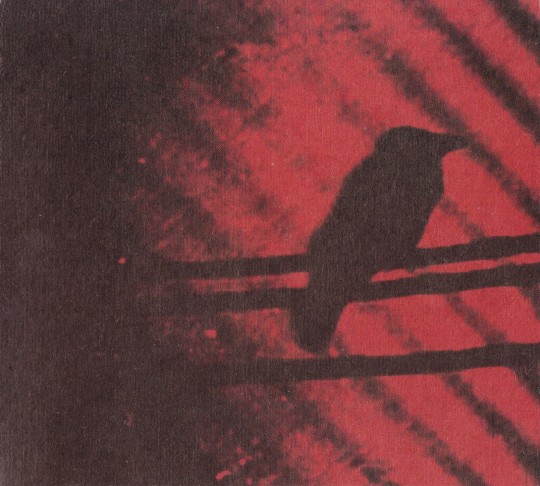
"Born Into Trouble as the Sparks Fly Upward." The Silver Mt. Zion Memorial Orchestra & Tra-La-La Band 2001, Constellation (Bandcamp)
22 years ago Montreal’s other iconic prodigiously-membered post-rock band released their second LP. It’s not easy keeping all of these pro-Zion-but-not-Zionists straight, so I’ve helpfully listed and ranked each of the musicians who have passed through this constantly shifting collective from first to least-first. Let’s go!
Members of A/The/e Silver Mt. Zion Memorial Orchestra & Tra-La-La Band, Ranked
1. Mike Garson - piano 2. Annie Clark - guitar, keyboards, backing vocals 3. Brian Teasley- percussion 4. Daniel Hart - violin 5. Szabolcs Szczur – accordion 6. Davey 'Crabsticks' Trotter – Mellotron 7. Timothy Matthews – mbira 8. Buffi Jacobs – cello 9. Bach Norwood – piano, keyboards, backing vocals 10. Harriet Ballance - triangle, backing vocals 11. Japhy Ryder – floristry 12. Stuart "Peebs" Peebles – piccolo 13. Chandler Petrino – natural horn, oboe 14. Jared Pechonis – theremin 15. Toby Halbrooks - theremin 16. Corn Mo - backing vocals 17. Patrick Hewitt – theremin 18. Darin Hieb – trumpet, backing vocals 19. Rachel Woolf – flute 20. Mark Beardsworth – claviola 21. Allen Halas – percussion 22. Edwin Mendoza – viola 23. Todd Beaupré – vibraslap 24. Thaddeus Ford – trumpet 25. Paul Deemer – trombone, trumpet 26. Mike St.Clair – trombone, synth effects 27. Josh Guyer – trombone, spoons 28. Chris Curiel – trumpet 29. Heather Test – French horn 30. Victoria Arellano – classical harp 31. Sean Redman – violin, mandolin 32. Kelly Test – percussion 33. Mike Mordecai – percussion 34. Jason Garner – drums 35. Audrey Easley – flute, piccolo, EWI 36. Rick G. Nelson – viola 37. Nick Groesch – piano, keyboards 38. Keith Hendricks – percussion 39. Evan Hisey – keyboards 40. Dylan Silvers – guitar 41. Daniel Hart – violin 42. John Lamonica – percussion 43. Marcus Lopez – percussion 44. Matt Bricker – trumpet, synth effects 45. Taylor Young – percussion 46. Joe Butcher – steel drum 47. Evan Jacobs – piano, keyboards 48. Todd Berridge – viola 49. Nick Earl – guitar 50. Evan Weiss – trumpet 51. Jay Jennings – trumpet 52. Tamara Brown – violin 53. Merritt Lota – steel drums 54. Daniel Huffman – guitar 55. Timothy Blowers – harp 56. Anthony Richards – steel drums 57. Louis Schwadron – French horn 58. Andrew Tinker – French horn 59. Nick Wlodarczyk – trombone 60. Paul Gaughran – flute 61. Isabelo Cruz – French horn 62. Bryan Wakeland – drums 63. Hayley McCarthy – viola 64. Dave Dusters – percussion, backing vocals 65. Billy Mills-Curran – flute 66. Logan Keese – trumpet 67. Ricky Rasura – classical harp 68. Tonya Hewitt – banjo 69. Daniel Poorman – slide whistle 70. Andy Parkerson – clarinet 71. Joseph Singleton – viola 72. Jenelle Valencia – violin 73. James Reimer – trombone 74. Regina Chellew – guitar, trumpet, backing vocals 75. Ryan Fitzgerald – guitar, backing vocals 76. Cory Helms – guitar, backing vocals 77. Jessica Jordan – backing vocals 78. Jenny Kirtland – backing vocals 79. Kristin Hardin – backing vocals 80. Elizabeth Evans – backing vocals 81. Neil Smith – backing vocals 82. Julie Doyle – backing vocals 83. Christine Bolon – backing vocals 84. Natalie Young – backing vocals 85. Constance Dolph – backing vocals 86. Elizabeth Brown – backing vocals 87. Apotsala Wilson – backing vocals 88. Jennie Kelley – backing vocals 89. Roy Thomas Ivy – backing vocals 90. Jamey Welch – backing vocals 91. Ethan Voelkers – backing vocals 92. Mark Pirro - bass 93. Frank Benjaminsen – backing vocals 94. Stephanie Dolph – backing vocals 95. Jennifer Jobe – backing vocals 96. Mike Elio – backing vocals 97. Kelly Repka – backing vocals 98. Jason Rees – backing vocals 99. Jeneffa Soldatic – backing vocals 100. Michael Turner – backing vocals 101. Don Congeler – backing vocals 102. Michael Musick – backing vocals 103. Melissa Crutchfield – backing vocals 104. Sandra Powers Giasson – backing vocals 105. Paul Hillery – backing vocals 106. Stephen Dix – backing vocals 107. Jessica Berridge – backing vocals 108. Melisma MacDonald – backing vocals 109. Ross Cink - backing vocals 110. Lucy Williams - choreography 111. Josh David Jordan – backing vocals 112. Brad Butler – backing vocals 113. Jason Rees – backing vocals 114. Andrew Aldenenotti – backing vocals 115. Getting hit by a bus wearing a flowing white robe 116. Tim DeLaughter - vocals, guitar, piano
Hold on. I’ve just received word that these musicians are actually members of some other band? Apologies for the confusion!
youtube
157/365
#backing vocals#a silver mt. zion#efrim manuel menuck#defector#this is so stupid#montreal music#'00s music#post-rock#underexplained lists#music review#vinyl record#montreal
5 notes
·
View notes
Text
Moondog: An Unlikely Hero of Music
Moondog, born Louis Thomas Hardin in 1916, was an American musician, poet, and composer. He became blind at the age of 16 and later became a street musician in New York City, where he gained popularity in the 1940s and 1950s. Moondog’s music style was unique, combining elements of classical music, jazz, and Native American music. Moondog’s influence on minimalist composers like Philip Glass can…

View On WordPress
#Bjork#minimalism#minimalist music#Moondog#music#music discussion#Music Education#musician#online learning#Philip Glass#Sonic Youth#Steve Reich#The Mars Volta
3 notes
·
View notes
Text
LÉGENDES DU JAZZ
HAZEL SCOTT, LA PIANISTE QUI AVAIT TENU TETE À LA DISCRIMINATION RACIALE
“I’ve been brash all my life, and it’s gotten me into a whole lot of trouble. But at the same time, speaking out has sustained me and given meaning to my life.”
- Hazel Scott
Née le 11 juin 1920 à Port of Spain, à Trinidad, Hazel Dorothy Scott était la fille unique de R. Thomas Scott, un chercheur originaire d’Afrique de l’Ouest basé à Liverpool, en Angleterre, et d’Alma Long Scott, une pianiste classique, saxophoniste et enseignante. Hazel avait quatre ans lorsque sa famille avait quitté Trinidad pour s’installer à Harlem. Après avoir travaillé comme domestique, la mère de Scott avait appris à jouer du saxophone en autodidacte avant de se joindre au groupe de Lil Hardin et de Louis Armstrong dans les années 1930.
Après la séparation de ses parents en 1924, Scott avait été élevée par sa mère et sa grand-mère à Harlem. Sous la supervision de sa mère, Scott avait bientôt appris à maîtriser les principales techniques du piano classique. Dotée d’une excellente mémoire, Scott pouvait interpréter à la perfection n’importe quelle pièce de musique même si elle ne l’avait entendue qu’une seule fois. On raconte même que Scott avait l’habitude de huer les élèves de sa mère lorsqu’ils faisaient une fausse note !
Sa mère s’étant liée d’amitié avec plusieurs musiciens afro-américains majeurs, cela avait permis à Scott de fréquenter des légendes du jazz comme Art Tatum, Billie Holiday, Lester Young et Fats Waller. Plutôt que de devenir pianiste de concert, la mère de Scott avait décidé de se consacrer exclusivement à la carrière de sa fille. Très reconnaissante envers sa mère, Scott avait déclaré quelques années plus tard: ‘’She was the single biggest influence of my life.’’
Même si l’âge minimum était de seize ans, Scott était si talentueuse qu’elle avait reçu des bourses pour étudier à la Juilliard School of Music à partir de l’âge de huit ans. L’interprétation par Scott du “Prelude in C-Sharp Minor” de Rachmaninoff avait convaincu le directeur de l’école, Frank Damrosch, de faire une exception pour la jeune élève et l’avait inscrit à des cours privés avec le professeur Oscar’ Wagner.
Scott était encore adolescente lorsqu’elle avait commencé à jouer professionnellement dans les clubs de la ville. En 1933, la mère de Scott avait fondé un groupe appelé Alma Long Scott's All-Girl Jazz Band, dans lequel sa fille jouait du piano et de la trompette.
DÉBUTS DE CARRIERE
À l’âge de seize ans, tout en poursuivant parallèlement ses études, Scott se produisait régulièrement dans le cadre d’émissions de radio de la Mutual Broadcasting System, ce qui lui avait valu la réputation de grande pianiste classique. À l’âge de quinze ans, Scott s’était également produite au légendaire Roseland Dance Hall avec l’orchestre de Count Basie. À la même époque, Scott avait aussi fait des apparitions dans des comédies musicales comme la revue du Cotton Club de 1938, et les productions ‘’Sing Out the News’’ et ‘’The Priorities of 1942.’’ Malgré son agenda plutôt chargé, Scott avait décroché son diplôme d’études secondaires avec distinction. Très cultivée, Scott était également polyglotte: elle parlait sept langues.
En 1940, à l’âge de seulement vingt ans, Scott avait enregistré un premier album intitulé ‘’Swinging the Classics’’ qui avait été généreusement salué par la critique.
Durant les années 1930 et 1940, Scott s’était produite dans de nombreux clubs de nuit, dans lesquels elle avait exploré différents styles musicaux, du jazz au blues en passant par les ballades, les succès de Broadway, les chansons de boogie woogie et la musique classique. Défiant la discrimination raciale qui prévalait à l’époque, Barney Josephson avait fondé un des premiers clubs multi-raciaux sous le nom de Café Society, qui permettait aux artistes de se produire sur scène indépendamment de leur race ou de leur origine ethnique. Lorsqu’elle avait terminé son contrat au Café Society en 1939, la chanteuse Billie Holiday, qui se considérait un peu comme la grande soeur de Scott, lui avait obtenu une audition avec le propriétaire du club. Barney Josephson était éventuellement devenu son gérant et lui avait même obtenu des contrats à Hollywood.
Scott avait été une des principales attractions du club de 1939 à 1943, contribuant ainsi à populariser la musique classique auprès du grand public. Scott s’était même mérité le surnom de ‘’Darling of Café Society.” En 1941, à l’âge de seulement vingt ans, Scott s’était produite en solo à Carnegie Hall. Le programme du concert comprenait la deuxième rhapsodie hongroise de Franz Liszt, la pièce “Two-Part Inventions” de Jean-Sébastien Bach et la “Minute Waltz” de Frédéric Chopin.
Un critique du New York Times avait commenté: “The shining star of the evening was… Hazel Scott, who can play the piano, straight and swing; who can sing, and who can decorate any stage you like.” Le critique avait ajouté: “She gave performances that had immense gusto and wit. It’s a good guess that the composers would not have minded.”
Comme pianiste, Scott commençait habituellement par jouer une mélodie classique connue, avant de se mettre à improviser et à incorporer graduellement le jazz dans le cadre de ses prestations. Même si Scott n’était pas la première à tenter de fusionner le jazz avec la musique classique, son talent naturel avait rapidement séduit les amateurs.
Sur le film ‘’The Heat’s On’’ tourné en 1943, Scott s’était même produite avec un piano dans chaque main. En 1941 et 1943, Scott avait également été en vedette dans les concerts du Café Society intitulés ‘’From Bach to Boogie-Woogie’’ qui avaient été présentés à Carnegie Hall. Les concerts avaient éventuellement donné lieu à la publication de plusieurs albums qui avaient également remporté un grand succès.
Très populaire, Scott était vite devenue riche et gagnait environ 75 000$ par année (l’équivalent de 1 219 131$ au cours actuel). Comme l’avait déclaré sa biographe Karen Chilton, ‘’She was one of the highest-paid Black entertainers in show business at the time.’’ Vénérée par Duke Ellington et Frank Sinatra, Scott avait aussi son propre chauffeur. Ses mains avaient même été assurées par la célèbre compagnie Lloyds de Londres.
Après avoir fait des apparitions dans quelques comédies musicales de Broadway, Scott s’était installée à Los Angeles où elle avait signé un contrat avec RKO, un des plus importants studios d’Hollywood. Avec son amie la chanteuse Lena Horne, Scott était aussi devenue une des premières femmes de couleur à obtenir des rôles significatifs à Hollywood. Sûre d’elle, Scott avait même rejeté les quatre premiers rôles qui lui avaient proposés et qui la mettaient en scène dans le rôle d’une domestique (on se souvient que Billie Holiday avait commencé sa carrière au cinéma en jouant le rôle d’une domestique dans le film ‘’New Orleans’’ en 1947). Scott choisissait ses rôles avec soin et avait toujours refusé d’incarner des personnages subalternes.
Scott avait aussi insisté pour obtenir le dernier mot sur les séquences dans lesquelles elle était impliquée. À l’époque, les actrices de couleur étaient souvent habillées de façon plutôt vulgaire. Au cours du tournage du film ‘’The Heat’s On’’ tourné en 1943, Scott avait piqué une colère et avait abandonné le plateau de tournage en avertissant les producteurs qu’elle reviendrait pas avant que sa robe ait été remplacée. Trois jours plus tard, le réalisateur du film avait fini par donner satisfaction à Scott.
Scott avait tourné cinq films au cours de sa carrière, toujours en interprétant son propre rôle: ‘’I Dood It’’ (1943), ‘’The Heat's On’’ (1943), dans lequel elle était la seule actrice de couleur, ‘’Something to Shout About’’ (1943), ’’Broadway Rhythm’’ (1944), dans lequel elle partageait la vedette avec Lena Horne, et ‘’Rhapsody in Blue’’ (1945). Interprétant son propre rôle, Scott avait également insisté pour être créditée comme telle dans le générique et à porter ses propres bijoux et vêtements afin de protéger son image. Scott avait aussi exigé d’être payée au même salaire que les autres actrices blanches. Consciente de son talent, Scott avait même réussi à obtenir la somme faramineuse de 4000$ par semaine en guise de salaire.
Saluant le rôle de pionnier de Scott, Dwayne Mack, un professeur d’histoire au Berea College, avait déclaré: “She was Colin Kaepernick before Colin Kaepernick. She took a knee by refusing to wear an apron in a movie. She said: ‘I’d rather keep my dignity and my pride and my self-awareness and my Blackness than to sell out.’” Mack avait ajouté: “She understood how Blacks are depicted and portrayed: as criminals, as savages, mentally incompetent. She wanted broader roles for Black actors, more realistic roles for Black people.”
À l’été 1950, Scott avait écrit une page d’histoire en devenant la première Afro-Américaine à animer sa propre émission de télévision aux États-Unis, pavant ainsi la voie à des artistes comme Billy Daniels, Nat King Cole, Diahann Carroll, Sammy Davis, Jr. et Oprah Winfrey. Intitulée ‘’The Hazel Scott Show’’, l’émission d’une durée de quinze minutes avait été présentée en grande première sur les ondes du DuMont Television Network le 3 juillet 1950. Dans le cadre de l’émission, Scott jouait du piano, chantait et interprétait un mélange de musique classique, de jazz, de blues et de boogie woogie. Elle avait aussi conduit de nombreuses entrevues avec les personnalités de l’époque.
Après avoir commenté l’émission en déclarant: "Hazel Scott has a neat little show in this modest package", le magazine Variety avait ajouté: “Most engaging element in the air is the Scott personality, which is dignified, yet relaxed and versatile.” L’émission était tellement populaire qu’elle avait bientôt été diffusée trois fois par semaine. Dans le cadre de l’émission, Scott se produisait régulièrement avec Charles Mingus et Max Roach qui faisaient partie de son groupe-maison. L’émission avait cependant connu une fin abrupte après que Scott ait été mentionnée dans un article dénonçant les sympathies communistes de plusieurs artistes d’Hollywood.
LA MILITANTE
Très active comme militante des droits civiques, Scott refusait catégoriquement de se produire dans des salles soumises à la réglementation sur la ségrégation lorsqu’elle était en tournée. Un jour, lors d’un concert à Austin, au Texas, Scott avait dû être escortée en dehors de la ville par des Rangers après avoir refusé de se produire dans une salle où les spectateurs blancs et noirs étaient assis dans des rangées séparées. Interrogée par le magazine Time, Scott avait expliqué: "Why would anyone come to hear me, a Negro and refuse to sit beside someone just like me?"
En 1949, avec l’appui de la National Association for the Advancement of Colored People (NAACP), Scott avait déposé une poursuite contre les propriétaires d’un restaurant de Pasco, dans l’État de Washington, après qu’une serveuse ait refusé de la servir avec sa compagne de voyage Mrs. Eunice Wolfe, sous prétexte qu’elles étaient de couleur. Lorsque Scott et Wolfe s’étaient rendus au poste de police pour porter plainte, l’officier de faction avait menacé de les arrêter pour avoir troublé la paix.
Après avoir obtenu un jugement favorable, Scott avait éventuellement commenté le verdict en déclarant: ‘’I sued and I won and I gave all the money to the NAACP.’’
Non seulement la victoire de Scott avait aidé le mouvement des droits civiques à combattre la discrimination raciale à Spokane, mais elle avait également inspiré les organisations de lutte pour les droits civiques à exercer des pressions sur l’État de Washington afin d’obtenir la mise en application du Public Accommodations Act en 1953. Adoptée en 1890, la loi qui offrait à tous les citoyens un accès égal aux lieux publics, avait été rendue inapplicable après que la législature de l’État ait levé toutes les pénalités imposées dans le cadre de la loi. Plusieurs militants des droits civiques avaient célébré la victoire de Scott.
Commentant l’activisme de Scott, sa biographe Karen Chilton avait expliqué: ‘’Hazel’s activism was more a natural compulsion than a premeditated, organized stance. It was simply how she was wired. It was her system of belief that justice, equity, fairness, and honesty should be a part of one’s everyday existence and present in one’s personal and professional interactions.’’
Mais le jugement avait aussi eu des répercussions négatives. L’année-même où Scott avait déposé sa poursuite, la ville de Portland, en Oregon, avait révoqué une ordonnance des droits civils qui interdisait aux commerces de la localité de faire de la discrimination relative à l’origine ethnique, la race ou la religion. Un résident de Portland, Jesse B. Helfrich, avait même ouvertement mentionné Scott et sa poursuite dans la lettre dans laquelle il justifiait son opposition à l’ordonnance, qu’il considérait inconstitutionnelle.
Le nom de Scott avait aussi été mentionné en juin 1950 dans un article du journal Red Channels intitulé ‘’Red Channels: A Report on Communist Influence in Radio and Television’’. L’article mentionnait également les noms de personnalités comme Leonard Bernstein et Orson Wells. Même si elle avait reçu un subpoena, Scott avait témoigné volontairement dans le cadre des audiences de la Commission des Activités Anti-Américaines (mieux connue sous le nom de Commission McCarthy) le 22 septembre 1950. Dans le cadre d’une déclaration écrite, Scott avait nié avoir jamais eu le moindre lien avec le Parti communiste ou aucune de ses organisations. Accusée d’avoir joué pour des organisations qui avaient des liens avec le Parti communiste, Scott avait admis qu’elle connaissait une seule d’entre elles, mais qu’elle ignorait à quelles organisations politiques elle était affiliée.
Après avoir reconnu avoir appuyé la candidature au conseil municipal du membre du Parti communiste Benjamin J. Davis, Scott avait précisé que Davis était appuyé par les socialistes, un groupe qui détestait les communistes plus fortement et depuis plus longtemps que tout autre mouvement. Scott avait aussi nié avoir jamais été membre du Parti communiste. Commentant le travail de la commission, Scott avait ajouté: “This is the day for the professional gossip, the organized rumor monger, the smear artist with the spray gun.”
Exprimant ses frustrations face au nombre de fausses accusations portées contre les personnalités de l’industrie du spectacle, Scott avait suggéré à la commission de cesser sa chasse aux sorcières et d’utiliser des méthodes démocratiques ‘’to immediately eliminate a good many irresponsible charges." Scott avait conclu son témoignage en faisant la déclaration suivante:
“…may I end with one request—and that is that your committee protect those Americans who have honestly, wholesomely, and unselfishly tried to perfect this country and make the guarantees in our Constitution live. The actors, musicians, artists, composers, and all of the men and women of the arts are eager and anxious to help, to serve. Our country needs us more today than ever before. We should not be written off by the vicious slanders of little and petty men.”
Les tentatives de Scott visant à laver son nom avaient été inutiles. Le mandat de la commission n’était qu’une parodie de justice. Dès qu’un nom apparaissait sur la liste noire, il était automatiquement considéré comme coupable.
Le témoignage de Scott n’avait pas tardé à faire la manchette des journaux. Moins d’une semaine après le témoignage de Scott, l’émission The Hazel Scott Show avait été retirée de l’horaire. Elle avait aussi perdu plusieurs contrats.
Il est possible que l’opposition de Scott à la discrimination avait contribué à en faire une cible, même s’il est impossible de le prouver avec certitude. Comme l’écrivait la biographe de Scott, Karen Chilton, ‘’She had no affiliations with the American Communist Party, but during the McCarthy era, she was an easy target as many Black artists who were vocal about civic rights for Black Americans were swept up into the mayhem of the Red Scare.’’ Se qualifiant elle-même d’’’Américaine par choix’’, Scott n’avait cure d’être mise sur une liste noire et désirait seulement vivre selon ses convictions. Elle avait ajouté: “I’ve been brash all my life, and it’s gotten me into a whole lot of trouble. But at the same time, speaking out has sustained me and given meaning to my life.”
Toujours fière d’être américaine malgré toutes les persécussions dont elle avait fait l’objet, Scott avait commenté: ‘’I believe America is as big and as strong as its weakest point… it is up to the Negro to be the conscience of this great land of ours.”
DERNIERES ANNÉES
Les démêlés de Scott avec la Commission McCarthy l’avaient énormément affecté. Après avoir été victime d’une dépression nerveuse en 1951, Scott avait recommencé à se produire aux États-Unis et en Europe. Elle avait aussi fait des apparitions sporadiques sur des émissions de variétés comme la Cavalcade of Stars. Scott avait même participé à un épisode de l’émission Wonderful Town animée par Faye Emerson et diffusée sur le réseau CBS. Malgré sa disparition, l’émission de Scott avait donné un rayon d’espoir aux téléspectateurs afro-américains à une époque où les biais raciaux utilisés par l’industrie de la télédiffusion étaient encore prédominants. Malgré toutes les entraves dont elle avait souffert personnellement, Scott était demeurée une adversaire farouche du McCarthisme et de la ségrégation raciale durant toute sa carrière.
Placée sur une liste noire, Scott s’est éventuellement installée à Paris en 1957. Son appartement du huitième arrondissement était d’ailleurs devenu le site de plusieurs jam sessions auxquelles avaient participé de grands noms du jazz comme Lester Young, Mary Lou Williams, Dizzy Gillespie, Max Roach et Duke Ellington. Le fils de Scott, Adam Clayton Powell III, se rappelait que sa mère avait reçu Ellington pour dîner. Billie Holiday était aussi venue célébrer la Thanksgiving. Powell se souvenait également avoir joué aux échecs avec Quincy Jones sur le plancher de l’appartement. Durant les vacances, Powell et sa mère se rendaient sur la plage de Cannes avec Lena Horne et Count Basie.
En 1958, Scott avait brièvement repris sa carrière d’actrice en faisant une apparition dans le film ‘’Le désordre et la nuit’’ aux côtés de Jean Gabin. En 1963, Scott avait participé à une marche jusqu’à l’ambassade américaine à Paris avec un certain nombre d’Afro-Américains en exil, dont James Baldwin, afin d’appuyer la tenue de la Marche sur Washington organisée par Martin Luther-King.
Lorsque Scott est retournée aux États-Unis en 1967, elle avait été pratiquement oubliée. À l’époque, le jazz et le blues traversaient une période de déclin et avaient laissé la place au rock n’ roll et à la musique soul. Durant la même période, les pressions du mouvement des droits civiques avaient conduit à l’adoption d’une loi qui rendait la discrimination raciale illégale dans les édifices publics et renforçait la protection du droit de vote.
Après son retour aux États-Unis, Scott avait continué de se produire à l’occasion dans de petits clubs et d’enregistrer quelques disques. Scott avait aussi fait des apparitions à la télévision jusqu’à sa mort. Scott avait fait ses débuts comme actrice à la télévision en 1973 dans le soap opera ’’One Life to Live’’ dans lequel elle avait interprété une chanson lors du mariage de sa ‘’cousine’’ Carla Gray Hall, incarnée par Ellen Holly. Karen Chilton, qui a consacré en 2008 une biographie à Scott intitulée “Hazel Scott: The Pioneering Journey of a Jazz Pianist from Café Society to Hollywood to HUAC”, avait commenté: “Bitterness was not part of her package. There may have been a sense of longing, of frustration after she came back, of ‘Where do I fit in?’ But she loved music so much, she loved jazz so much….she never stopped playing.” De son côté, le journaliste Mike Wallace avait déclaré lors des funérailles de Scott en 1981: “She was gregarious. And sweet…she really lived.”
En août 1945, Scott avait épousé Adam Clayton Powell, Jr., le pasteur de l’Abyssinian Baptist Church de Harlem. En 1944, Powell était devenu le premier Afro-Américain à être élu au Congrès comme représentant de l’État de New York. Le mariage de Scott et Powell avait provoqué une certaine controverse, car Powell venait de divorcer cinq jours auparavant.
Plus important leader des droits civiques de l’époque, Powell n’avait rien à envier à Scott qui était son parfait alter ego. Le couple faisait la couverture des magazines, alimentait les potins et était fréquemment invité dans les soirées tant à New York qu’à Washington, D.C. L’avocate et militante des droits civiques Marjorie Lawson, qui était devenue par la suite la première femme juge de Washingon, avait confirmé: “She had every man in the room hanging on her every word. She was a sensation.” De son côté, le journaliste Mike Wallace avait commenté: ‘’They were stars, not only in the black world but the white world. That was extraordinary.’’ Le couple était même surveillé par le FBI lors de ses voyages à l’étranger. Pendant que Scott se produisait devant des salles à guichets fermés en Europe, Powell visitait les troupes américaines et enquêtait sur les conditions de vie des soldats de couleur.
Les choses avaient commencé à se gâter lorsque Powell avait commencé à exiger que Scott cesse de se produire dans les clubs.
Le couple, qui avait eu un fils, Adam Clayton Powell III (né en 1946), avait divorcé en 1960. À la fin de 1960, Powell s’était remarié avec sa secrétaire. Découragée, Scott avait avalé des pillules et avait tenté de se suicider à deux reprises.
Après s’être installée à Paris avec son fils en 1957, Scott s’était remariée le 19 janvier 1961 avec Ezio Bedin, un acteur d’origine suisse et italienne qui était de quinze ans son cadet. À Paris, Scott avait vécu une existence plus heureuse et détendue. Elle tenait des dîners où elle recevait des amis comme Billie Holiday, James Baldwin, Nina Simone, Lester Young et Quincy Jones. Le couple avait divorcé quelques années plus tard, avant le retour de Scott aux États-Unis.
Catholique de naissance, Scott avait entendu parler de la Baháʼí Faith (une religion qui était reconnue pour son humanisme) lors de conversations avec son ami de longue date Dizzy Gillespie, qui s’était joint au mouvement au début de 1968. Scott avait adhéré à l’organisation le 1er décembre de la même année.
En octobre 1970, Scott avait livré une performance lors de la remise de prix en éducation à New York organisée par la Baháʼí Faith. Scott avait interprété trois chansons: When the World was Young", "A lonely Christmas" et "Put a Little Love in Your Heart". L’interprétation de Scott avait été particulièrement louangée par Whitney Young, le directeur exécutif de la National Urban League, qui avait pris la parole dans le cadre de l’événement. En mai 1971, Scott avait également participé à une comédie musicale intitulée ‘’The Sounds of a New World", qui mettait aussi en vedette Gillespie, Seals and Crofts, Linda Marshall et plusieurs autres artistes. Présentée en Jamaïque, la revue faisait partie d’une tournée organisée par la Baháʼí Faith.
Hazel Scott est morte d’un cancer du pancréas le 2 octobre 1981 à l’hôpital du Mont Sinaï de Manhatan. Elle était âgée de soixante et un ans. Elle laissait dans le deuil son fils Adam Clayton Powell III. Scott a été inhumée au Flushing Cemetery dans le Queens, aux côtés d’autres légendes du jazz comme Louis Armstrong et Johnny Hodges. Son ami Dizzy Gillespie avait été enterré près de Scott après son décès en 1993. Scott avait présenté son dernier concert deux mois avant sa mort. Au moment de son décès, Scott rêvait d’écrire de la musique sacrée, une suite de jazz et même un opéra.
Le fils de Scott, Adam Clayton Powell III, a légué les archives de sa mère à la Bibliothèque nationale du Congrès en 2020. La collection comprend près de 4000 pièces et est composée d’enregistrements, d’agendas, de contrats, de partitions musicales et de photographies. On retrouve également dans la collection l’autobiographie non publiée de Scott. En léguant les archives de sa mère, Powell avait précisé: ‘’I’ve always wanted to do what I could to make sure that she was not lost. Her intelligence and her talent and her values and her stubbornness as it were, so it could be something that was accessible to everybody.” Convaincu que sa mère avait été traitée injustement, Powell avait ajouté: “She was very committed to what she believed to be correct.”
Même si Scott avait gagné des millions de dollars au cours de sa carrière, l’impôt s’était accaparé d’environ 90% de ses revenus. Les avocats et les comptables s’étaient emparés du reste. Le Internal Revenue Service avait finalement reconnu que Scott devait plus d’argent qu’elle n’était en mesure de rembourser. Elle était dont morte dans la pauvreté.
Reconnu comme pianiste de jazz virtuose, Scott avait aussi connu du succès comme actrice et musicienne classique. Très impliquée socialement, Scott s’était servie de sa célébrité pour combattre la ségrégation raciale et contribuer à la défense des droits civiques. Scott avait également enregistré plusieurs albums comme leader, notamment dans le cadre d’un trio composé du contrebassiste Martin Rivera et du batteur Bill English. Scott a aussi dirigé un trio avec Charles Mingus et le batteur Rudie Nichols. En janvier 1955, le trio a enregistré un album intitulé ‘’Relaxed Piano Moods’’, qui est généralement bien considéré par la critique. Le style unique de Scott combinant le swing, le jazz et les influences classiques avaient permis à la pianiste de maintenir sa popularité jusqu’à la fin de sa vie. En 2001, le réseau NPR a rendu hommage à Scott en intronisant son album en trio avec Charles Mingus et Max Roach au sein de la Basic Jazz Record Library.
Citant Scott comme sa principale influence lors de sa prestation dans le cadre de la 61e édition des Grammy Awards en 2019, l’autrice-compositrice Alicia Keys avait déclaré: ‘’I’ve been thinking so much about the people and the music that have inspired me, and I wanna give a shout out to Hazel Scott, because I’ve always wanted to play two pianos.’’ Dans le cadre de sa prestation, Keys avait interprété le classique ‘’Maple Leaf Rag’’ de Scott Joplin.
Dans son ouvrage intitulé "When Women Invented Television’’, l’écrivaine Keishin Armstrong a également mentionné Scott comme une des quatre femmes qui avaient eu une influence majeure sur la télévision. En 2020, Scott avait été l’objet d’une émission spéciale de la BBC intitulée ‘’Hazel Scott: Jazz star and barrier breaker.’’ Un vidéo de son interprétation de la pièce ‘’Takin’ A Chance’’ (1943) a été visionné par neuf millions d’abonnés sur Facebook et a été partagé sur d’autres médias sociaux par l’entremise du tag #BlackGirlMagic.
En 2022, la compagnie Dance Theatre de Harlem a présenté un ballet en hommage à Scott. Décrivant les réalisations de Scott, sa biographe Karen Chilton avait commenté: “Her accomplishments are so broad: This is a woman who studied at Juilliard at 8 years old when the entrance age was 16, who had her own radio show at 14, who was on Broadway by 18 and was a star at 19. It really is the legacy of a prodigy, of a Black female prodigy.’’
©-2024, tous droits réservés, Les Productions de l’Imaginaire historique
0 notes
Text
Louis Thomas Hardin (May 26, 1916 – September 8, 1999)
youtube

Martin Elkort Moondog, New York City 1950
"I am an observer of life, a non-participant who takes no sides. I am in the regimented society, but not of it." Moondog
137 notes
·
View notes
Photo

The following characters have been accepted into Athos! Please get your account ready and send it into the main within twenty-four hours - if you need more time, let the admin team know and we will grant you an extension. We are excited to have you here and we can’t wait to see your characters in action!
Fives as Pax Serrano with the faceclaim of Oscar Isaac
Fives as Alystair Astaze with the faceclaim of Dylan Sprayberry
Ray as Maddox Flanagan with the faceclaim of Luke Macfarlane
Ace as Felix Valerious with the faceclaim of Joshua Orpin
X as Mateo Kelly with the faceclaim of Tyler Posey
X as Landon James with the faceclaim of Jordan Fischer
Wolfe as Sebastian Huster with the faceclaim of Jonathan Majors
Wolfe as Ambrose LaCroix with the faceclaim of Thomas Doherty
Wolfe as Godric Buchert with the faceclaim of Kellan Lutz
Devil as Louis LaFontaine with the faceclaim of Sam Hueghan
Audrey as Hardin Burke with the faceclaim of Theo James
1 note
·
View note
Text
youtube
Moondog ~ Elf Dance
"Louis Thomas Hardin (May 26, 1916 – September 8, 1999) also known as Moondog, was an American musician, composer, theoretician, poet and inventor of several musical instruments. He was blind from the age of 16.
Hardin lived in New York City from the late 1940s until 1972, and during this time he could often be found on 6th Avenue, between 52nd and 55th Streets, wearing a cloak and a horned helmet, sometimes busking or selling music, but often just standing silently on the sidewalk. He was widely recognized as "the Viking of 6th Avenue" by thousands of passersby and residents who weren't aware of his musical career."
~via Wikipedia
#moondog#louis thomas hardin#musician#poet#inventor#composer#viking#6th avenue#artist#eccentric#cool
2 notes
·
View notes
Photo

#Illustration#character#Character Design#kidlit#kidlit art#moondog#viking of 6th avenue#louis thomas hardin#viking#musician
0 notes
Audio
SONG OF THE DAY Bifrost -- Louis Thomas Hardin, Moondog
0 notes
Video
youtube
Moondog & The London Saxophonic, »New Amsterdam« from the album »Sax Pax For Sax«, recorded 1994, released 1997.
2 notes
·
View notes
Text
The people at the center of a multi-state killing spree and manhunt last year pleaded guilty to several charges in York and Chester counties on Wednesday.
Tyler Terry and Adrienne Simpson are accused of killing five people between South Carolina, Tennessee and Missouri. They’re also accused of shooting at officers who chased them in Chester County.
PREVIOUS: ‘He had nowhere to go’: Accused killer captured in SC after weeklong manhunt
Simpson was arrested following the chase in May 2021, but Terry ran into the woods, triggering a weeklong manhunt.
On Wednesday, Terry and Simpson entered guilty pleas for multiple charges, including several counts of murder and attempted murder. The judge accepted the pleas from both of the defendants and the two agreed to life in prison with no parole on all charges.

Here’s a timeline of the crimes the two are connected to and their arrests:
May 2, 2021: Terry allegedly kills 35-year-old Thomas Hardin on Lowry Row in York County. He is also a suspect in two other shootings that also occurred at Erlich Street in Chester and at Taco Bell on JA Cochran Bypass on the same day. Police say Simpson drove the vehicle during the crimes.
May 15, 2021, between 8-9 p.m.: The pair allegedly drives to St. Louis. Once there, they steal a license plate from a truck parked in the driveway of a St. Louis County home and put it on their car.
May 15, 2021 10:50 p.m.: Terry and Simpson allegedly shoot Stanley and Barbara Goodkin in a St. Louis suburb. Barbara was fatally shot in the head, Stanley was shot in the chest, but his cell phone stopped the bullet.
May 15, 2021 shortly before midnight: Terry and Simpson reportedly shoot and kill Dr. Sergei Zacharev outside a Drury Inn while he is waiting for an Uber.
May 16, 2021: Terry and Simpson allegedly travel to north St. Louis to purchase drugs before returning to South Carolina.
May 17, 2021 2 a.m.: Memphis police officers found a man between 35-45 years old lying unresponsive in the road, near a car that had its emergency flashers on. Police said he has been shot during what looked to be a robbery. Investigators planned to take out warrants against Terry and Simpson for the homicide.
May 17, 2021 11 p.m.: Chester County deputies say they try to stop Terry and Simpson’s vehicle -- the same one connected to the St. Louis murders. The suspects reportedly lead them on a high-speed chase while firing shots at deputies. The chase ends in a crash and Simpson is arrested, but Terry ran into nearby woods.
May 19, 2021: The body of Simpson’s husband -- Eugene -- is found in Great Falls, South Carolina. He had been missing since May 2.
May 21, 2021: Investigators charge Terry and Simpson for Eugene’s murder.
May 24, 2021: Tyler Terry is found in Chester County and taken into custody.
6 notes
·
View notes
Text
Smoking and other Hobbies
-Click here to return to the index for Stranger Missions-
(This post includes photos of all cigarette cards but not locations)
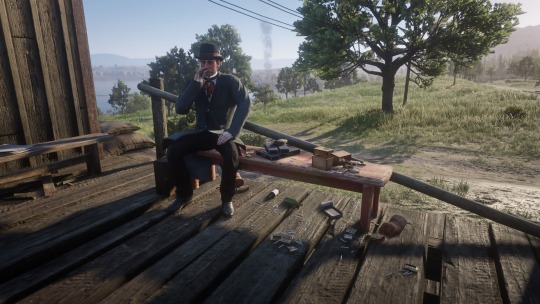
Cards are listed and displayed in order from left to right, top to bottom. (ie. 1,2,3,4 not 1,5,7,10)
Amazing Inventions Card Set:
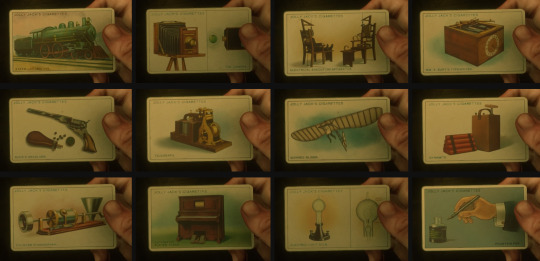
Steam Locomotive 1814 - George Stephenson
Camera 1814 - Joseph Nicephore Niepce
Electrical Execution Apparatus 1888 - H.P. Brown A. Kennelly
Typewriter 1829 - W.A. Burt
Revolver 1836 - Daniel Buck
Telegraph 1837 - Samuel Morse
Manned Glider 1893 - Charles Kinnear
Dynamite 1866 - Alfred Nobel
Cylinder Phonograph 1877 - Thomas Edison
Player Piano 1829 - Edward Leveaux
Electric Light Bulb 1876 - Thomas Edison
Fountain Pen 1884 - Lewis Waterman
Artists, Writers, & Poets Card Set:
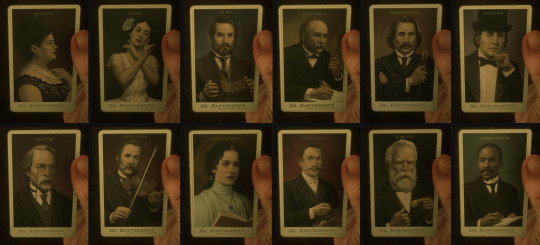
Edith Corinne
Elsie Rose
W.G. Hoyt
Aldous Bramley
Preston T. Stephenson
Evelyn Miller
Slick Hutton
Laurence Carson
Miss Maud Delancey
Charles Châtenay
George Dixie
Richard McCullough
Famous Gunslingers Card Set:
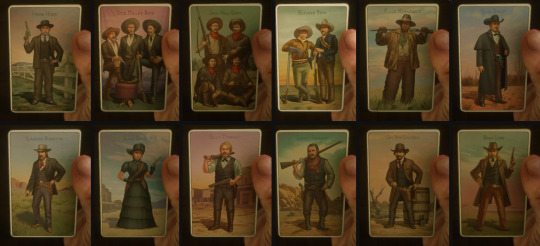
Frank Heck
Otis Miller Boys
Jack Hall Gang
Butcher Brothers
Flaco Hernandez
Slim Grant
Landon Ricketts
Black Belle
Billy Midnight
Emmet Granger
Jim "Boy" Calloway
Bart Love
Fauna of America Card Set:
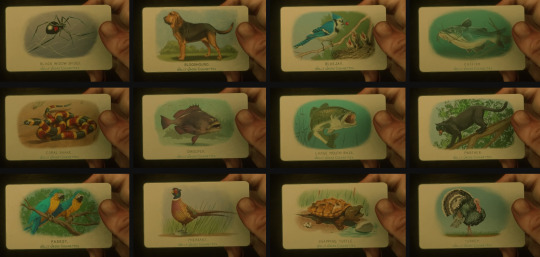
Black Widow Spider
Bloodhound
Bluejay
Catfish
Coral Snake
Grouper
Largemouth Bass
Panther
Parrot
Pheasant
Snapping Turtle
Turkey
Flora of America Card Set:

Golden Current
Hummingbird Sage
Oleander Sage
Yarrow
Indian Tabacco
Black Mangrove
Longleaf Pine
Desert Fan Palm
Coastal Redwood
Horse Crippler Cactus
Blazing Star
Carolina Lupine
Gems of Beauty Card Set:
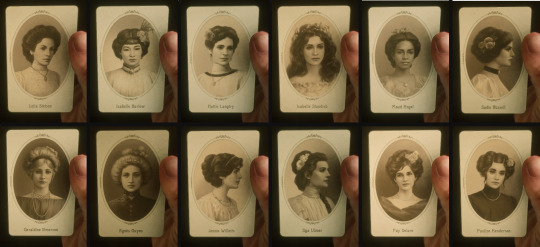
Lelia Stentson
Isabelle Barlow
Hattie Langtry
Isabelle Standish
Maud Engel
Sadie Russell
Geraldine Emerson
Agnes Guyon
Jennie Willetts
Ilga Ulmer
Fay Delaro
Pauline Henderson
Horses Card Set:
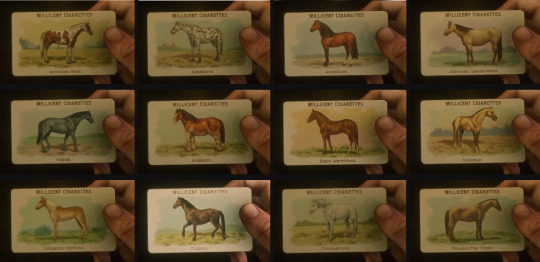
American Paint
Appaloosa
Andalusian
American Standardbred
Nokota
Ardennes
Dutch Warmblood
Turkoman
Hungarian Half-bred
Mustang
Thoroughbred
Missouri Fox Trotter
Marvels of Travel Card Set:

Packet Ship
Schooner
Camel Caravan
Elephant Carriage
Goat Carriage
Hot Air Balloon
U.S. Frigate
The Showboat
Balener Whaling Vessel
Stagecoach
Steam Locomotive
Velocipede
Prominent Americans Card Set:
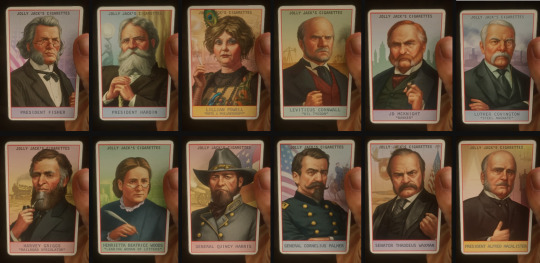
President Fisher
President Hardin
Lillian Powell
Leviticus Cornwall
JD McKnight
Luther Covington
Harvey Griggs
Henrietta Beatrice Woods
General Quincy Harris
General Cornelius Palmer
Senator Thaddeus Waxman
President Alfred MacAlister
Stars of the Stage Card Set:

Laurence Dunn
Louis Durand
Jesse Raymond
Augusta Tremlow
Mabel Potter
Robin Koninsky
Isadore Reid
Irene Grubb
Nettie Palmer
Jim Cobb
Mittie Comstock
Robert Elliot Patchen
Vistas of America Card Set:
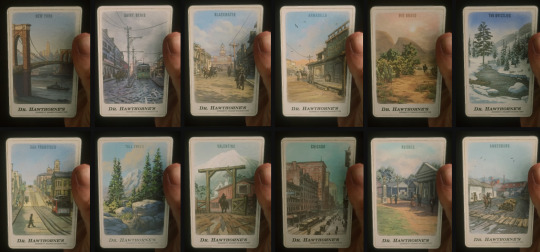
New York
Saint Denis
Blackwater
Armadillo
Rio Bravo
The Grizzlies
San Francisco
Tall Trees
Valentine
Chicago
Rhodes
Annesburg
World Champions Card Set:
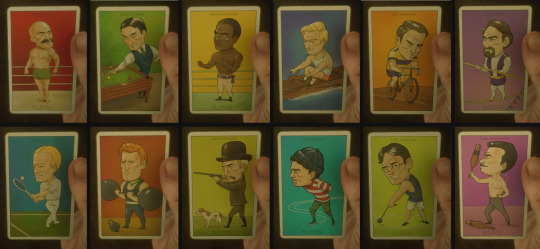
Greco Roman Wrestler - Percy Wood
Billiards - Edwin A. Rowe
Pugilist - Theobaud Getzin
Oarsman - H.T. Slocum
Cyclist - R.S. Harradon
Walker - E.D. Ewing
Lawn Tennis - Patsey Hill
Weightlifter - William Sleicher
Pigeon Shooting - Edwin Singerly
Skater - Felix Hawley
Hammer Thrower - Capt. Jack Page
Swinger - Axel McCormack
9 notes
·
View notes
Video
youtube
Moondog - New Amsterdam
From 1997 album "Sax Pax For A Sax"
Louis Thomas Hardin (May 26, 1916 – September 8, 1999), known as Moondog, was an American musician, composer, theoretician, poet and inventor of several musical instruments. Largely self-taught as a composer, his work drew inspiration from jazz, Classical, native American music, and was strongly rhythmic and contrapuntal, in some ways anticipating the minimalism of Steve Reich and Philip Glass.
He was blind from the age of 16. Hardin lived in New York City from the late 1940s until 1972, and during this time he could often be found on 6th Avenue, between 52nd and 55th Streets, wearing a cloak and a horned helmet sometimes busking or selling music, but often just standing silently on the sidewalk. He was recognized as "the Viking of 6th Avenue" by thousands of passersby and residents who were not aware of his musical career.
6 notes
·
View notes